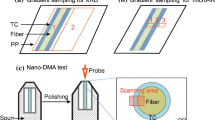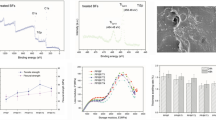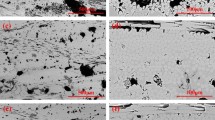Abstract
Transcrystallinity (TC) developing on the fiber surface of natural fiber/semicrystalline polymer composites shows great application potential in interfacial enhancement. The local mechanical properties of TC play a vital role in understanding the interphase interaction mechanism. In this study, TC was firstly introduced in bamboo fiber-anchored nano-TiO2/polypropylene (PP) composite and subsequently the local mechanical properties of TC were measured in situ on nanoscale by static nanoindentation tests. Results showed that pristine bamboo fiber had poor nucleation ability for the crystallization of PP, while the fiber incorporated with nano-TiO2 could successfully form the TC in composites because of the effect of nano-TiO2 on inducing heterogeneous nucleation and the increase in fiber surface roughness which led to a higher nucleation ability. The interfacial stress transfer ability of composites was quantitatively evaluated by interfacial shear strength (IFSS). The results revealed that the IFSS of composites with interfacial TC increased by 48.9% compared with the composite without TC and the IFSS increased nonlinearly with the thickening of TC. Nanoindentation tests results demonstrated that the hardness (H) and modulus of elasticity (E) were increased by 53.46 and 24.65% in composite interphase due to the formation of TC. The correlation analysis indicated that better local mechanical properties of the interphase resulted in higher interfacial stress transfer ability in composites.






Similar content being viewed by others
References
Amitay-Sadovsky E, Cohen SR, Wagner HD (1999) Anisotropic nanoindentation of transcrystalline polypropylene by scanning force microscope using blade-like tips. Appl Phys Lett 74:2966–2968. https://doi.org/10.1063/1.123981
Amitay-Sadovsky E, Cohen SR, Wagner HD (2001) Nanoscale shear and indentation measurements in transcrystalline α-isotactic polypropylene. Macromolecules 34:1252–1257. https://doi.org/10.1021/ma001193d
Bagwasi S, Tian B, Zhang J, Nasir M (2013) Synthesis, characterization and application of bismuth and boron Co-doped TiO2: a visible light active photocatalyst. Chem Eng J 217:108–118. https://doi.org/10.1016/j.cej.2012.11.080
Borysiak S (2012) Fundamental studies on lignocellulose/polypropylene composites: effects of wood treatment on the transcrystalline morphology and mechanical properties. J Appl Polym Sci 127:1309–1322. https://doi.org/10.1002/app.37651
Boukehili H, Nguyen-Tri P (2012) Helium gas barrier and water absorption behavior of bamboo fiber reinforced recycled polypropylene. J Reinf Plast Compos 31:1638–1651. https://doi.org/10.1177/0731684412464090
Campbell D, Qayyum MM (1977) Enhanced fracture strain of polypropylene by incorporation of thermoplastic fibers. J Mat Sci 12:2427–2434. https://doi.org/10.1007/BF00553929
Chen H, Cheng H, Wang G, Yu Z, Shi SQ (2016) Tensile properties of bamboo in different sizes. J Wood Sci 61:213. https://doi.org/10.1007/s10086-016-1537-8
Chen PY, Lian HY, Shih YF, Chen W, Su M, Jeng RJ (2017) Preparation, characterization and crystallization kinetics of Kenaf fiber/multi-walled carbon nanotube/polylactic acid (PLA) green composites. Mater Chem Phys 196:249–255. https://doi.org/10.1016/j.matchemphys.2017.05.006
Chen XY, Guo QP, Mi YL (1998) Bamboo fiber-reinforced polypropylene composites: a study of the mechanical properties. J Appl Polym Sci 69:1891–1899. https://doi.org/10.1002/(SICI)1097-4628(19980906)69:10%3c1891::AID-APP1%3e3.0
Cho K, Kim D, Yoon S (2003) Effect of substrate surface energy on transcrystalline growth and its effect on interfacial adhesion of semicrystalline polymers. Macromolecules 36:7652–7660. https://doi.org/10.1021/ma034597p
Fang L, Lu X, Zeng J, Chen Y, Tang Q (2020) Investigation of the flame-retardant and mechanical properties of bamboo fiber-reinforced polypropylene composites with melamine pyrophosphate and aluminum hypophosphite addition. Materials. https://doi.org/10.3390/ma13020479
Fei P, Fei BH, Yu Y, Xiong HG, Tan J (2014) Thermal properties and crystallization behavior of bamboo fiber/high-density polyethylene composites: nano-TiO2 effects. J Appl Polym Sci. https://doi.org/10.1002/app.39846
Felix JM, Gatenholm P (1994) Effect of transcrystalline morphology on interfacial adhesion in cellulose/polypropylene composites. J Mater Sci 29:3043–3049. https://doi.org/10.1007/BF01117618
Folkes MJ, Hardwick ST (1987) Direct study of the structure and properties of transcrystalline layers. J Mate Sci Lett 6:656–658. https://doi.org/10.1007/BF01770916
Gassan J, Mildner I, Bledzki AK (2001) Transcrystallization of polypropylene on different modified jute fibers. Compos Interfaces 8:443–452. https://doi.org/10.1163/156855401753424488
Han G, Deng J, Zhang S, Bicho P, Wu Q (2010) Effect of steam explosion treatment on characteristics of wheat straw. Ind Crops Prod 31:28–33. https://doi.org/10.1016/j.indcrop.2009.08.003
Han S, Ren K, Geng C, Wang K, Zhang Q, Chen F, Fu Q (2014) Enhanced interfacial adhesion via interfacial crystallization between sisal fiber and isotactic polypropylene: direct evidence from single-fiber fragmentation testing. Polym Int 63:646–651. https://doi.org/10.1002/pi.4551
Hata T, Ohsaka K, Yamada T, Nakamae K, Shibata N, Matsumoto T (2006) Transcrystalline region of polypropylene - its formation, structure and mechanical-properties. J Adhes 45:125–135. https://doi.org/10.1080/00218469408026633
Huang J, Xu CJ, Wu DF, Lv QL (2017) Transcrystallization of polypropylene in the presence of polyester/cellulose nanocrystal composite fibers. Carbohydr Polym 167:105–114. https://doi.org/10.1016/j.carbpol.2017.03.046
Huang YH, Fei BH (2017) Comparison of the mechanical characteristics of fibers and cell walls from moso bamboo and wood. BioResources 12:8230–8239
Jhu YS, Hung KC, Xu JW, Wu TL, Wu JH (2021) Transcrystallization of the acetylated bamboo fiber/polypropylene composite under isothermal crystallization. Wood Sci Technol Health Care 55:797–810. https://doi.org/10.1007/s00226-021-01279-5
Jing M, Jiang H, Guo Y, Wu Z, Fu Q (2016) Transcrystallization of poly(L-lactic acid) on the surface of reduced graphene oxide fibers. RSC Adv 6:100090–1000097. https://doi.org/10.1039/c6ra18762e
Kelly A, Tyson WR (1965) Tensile properties of fibre-reinforced metals - copper/tungsten and copper/molybdenum. J Mech Phys Solids 13:329. https://doi.org/10.1016/0022-5096(65)90035-9
Klein N, Marom G, Wachtel E (1996) Microstructure of nylon 66 transcrystalline layers in carbon and aramid fibre reinforced composites. Polymer 37:5493–5498. https://doi.org/10.1016/S0032-3861(96)00361-8
Leu SY, Yang TH, Lo SF, Yang TH (2012) Optimized material composition to improve the physical and mechanical properties of extruded wood–plastic composites (WPCs). Constr Build Mater 29:120–127. https://doi.org/10.1016/j.conbuildmat.2011.09.013
Li H, Zhang Y, Bai G, Zhang B (2016) Morphological and nanomechanical characterization of anisotropic interfacial characteristic regions in CF/PA6 composites at different cooling rates. J Appl Polym Sci. https://doi.org/10.1002/app.44106
Li LJ, Zhu SJ, Liu Z, Chen ZX (2005) Effect of drying treatment on properties of wood flour/PE composite. China Synth Resin Plast 3:28–31. https://doi.org/10.3969/j.issn.1002-1396.2005.03.006
Li Y, Jiang LY, Xiong CD, Peng WJ (2015) Effect of different surface treatment for bamboo fiber on the crystallization behavior and mechanical property of bamboo fiber/nanohydroxyapatite/poly(lactic-co-glycolic) composite. Ind Eng Chem Res 54:12017–12024. https://doi.org/10.1021/acs.iecr.5b02724
Lin CW, Ding SY, Hwang YW (2001) Interfacial crystallization of isotactic polypropylene molded against the copper surface with various surface roughnesses prepared by an electrochemical process. J Mater Sci 36:4943–4948
Liu H, Jiang Z, Zhang X, Liu X, Sun Z (2014) Effect of fiber on tensile properties of moso bamboo. BioResources 9:6888–6898. https://doi.org/10.1023/A:1011848623699
Loos J, Schimanski T, Hofman J, Peijs T, Lemstra PJ (2001) Morphological investigations of polypropylene single-fibre reinforced polypropylene model composites. Polymer 42:3827–3834. https://doi.org/10.1016/S0032-3861(00)00660-1
Matuana LM, Kamdem DP, Zhang J (2001) Photoaging and stabilization of rigid PVC/wood-fiber composites. J Appl Polym Sci 80:1943–1950. https://doi.org/10.1002/app.1292
Mi YL, Chen XY, Guo QP (1997) Bamboo fiber-reinforced polypropylene composites: crystallization and interfacial morphology. J Appl Polym Sci 64:1267–1273. https://doi.org/10.1002/(SICI)1097-4628(19970516)64:73.0.CO;2-H
Nielsen AS, Pyrz R (1998) Study of the influence of thermal history on the load transfer efficiency and fibre failure in carbon/polypropylene microcomposites using Raman spectroscopy. Compos Interfaces 6:467–482. https://doi.org/10.1163/156855499X00152
Ning N, Fu S, Zhang W, Chen F, Wang K, Deng H, Zhang Q, Fu Q (2012) Realizing the enhancement of interfacial interaction in semicrystalline polymer/filler composites via interfacial crystallization. Prog Polym Sci 37:1425–1455. https://doi.org/10.1016/j.progpolymsci.2011.12.005
Ren D (2017) The preparetion and properties of bamboo plastic composites with weathering resistance. Chinese Academy of Forestry
Ren D, Wang HK, Yu ZX, Wang H, Yu Y (2015) Mechanical imaging of bamboo fiber cell walls and their composites by means of peakforce quantitative nanomechanics (PQNM) technique. Holzforschung 69:975–984. https://doi.org/10.1515/hf-2014-0237
Shi S, Yang C, Nie M (2017) Enhanced interfacial strength of natural fiber/polypropylene composite with mechanical-interlocking interface. Acs Sustain Chem Eng 5:10413–10420. https://doi.org/10.1021/acssuschemeng.7b02448
Shih YF, Lai ZZ (2020) Green Composites based on poly (lactic acid) and bamboo fiber: flame retardancy, thermal, and mechanical properties. NAC 2019:61–69
Stern T, Marom G, Wachtel E (1997) Origin, morphology and crystallography of transcrystallinity in polyethylene-based single-polymer composites. Compos A 28:437–444. https://doi.org/10.1016/S1359-835X(96)00142-X
Tan LM, Yuan GM, Mu MM (2018) Research progress on the strengthening property of wood plastic composite. New Chem Mater 6:23–26
Varga J, KargerKocsis J (2015) Rules of supermolecular structure formation in sheared isotactic polypropylene melts. J Polym Sci Part B-Polym Phys 34:657–670. https://doi.org/10.1002/(SICI)1099-0488(199603)34:4%3c657::AID-POLB6%3e3.0.CO;2-N
Wang B, Wen T, Zhang X, Tercjak A, Cavallo D (2019) Nucleation of poly(lactide) on the surface of different fibers. Macromolecules 52:6274–6284. https://doi.org/10.1021/acs.macromol.9b01078
Wang C, Liu CR (1999) Transcrystallization of polypropylene composites: nucleating ability of fibres. Polymer 40:289–298. https://doi.org/10.1016/s0032-3861(98)00240-7
Wang C, Liu FH, Huang WH (2011) Electrospun-fiber induced transcrystallization of isotactic polypropylene matrix. Polymer 52:1326–1336. https://doi.org/10.1016/j.polymer.2022.01.036
Wang H, An X, Li W, Hao W, Yan Y (2014) Variation of mechanical properties of single bamboo fibers (Dendrocalamus latiflorus Munro) with respect to age and location in culms. Holzforschung 68:291–297. https://doi.org/10.1515/hf-2013-0081
Wang W, Sadeghipour K, Baran G (2008) Finite element analysis of the effect of an interphase on toughening of a particle-reinforced polymer composite. Compos A 39:956–964. https://doi.org/10.1016/j.compositesa.2008.03.016
Xiao F, Zhu LZ, Kong RY, Yu LL, Liang MJ (2021) Research progress on WPC strengthening and modification. New Chem Mater 49:5
Xie L, Shan B, Sun X, Tian Y, Xie H, He M, Xiong Y, Zheng Q (2017) Natural fiber-anchored few-layer graphene oxide nanosheets for ultrastrong interfaces in poly(lactic acid). Acs Sustainable Chem Eng 5:3279–3289. https://doi.org/10.1021/acssuschemeng.6b03101
Xu H, Hua G, Odelius K, Hakkarainen M (2016) Stereocontrolled entanglement-directed self-alignment of poly(lactic acid) cylindrites. Macromol Chem Phys 217:2567–2575. https://doi.org/10.1002/macp.201600364
Yin Y, Chen S, Chen P (2013) The effect of a graded interphase on the mechanism of stress transfer in a fiber-reinforced composite. Mech Mater 58:35–54. https://doi.org/10.1016/j.mechmat.2012.11.008
Zafeiropoulos NE, Baillie CA, Matthews FL (2001) A study of transcrystallinity and its effect on the interface in flax fibre reinforced composite materials. Compos A 32:525–543. https://doi.org/10.1016/S1359-835X(00)00058-0
Zarges JC, Kaufhold C, Feldmann M, Heim HP (2018) Single fiber pull-out test of regenerated cellulose fibers in polypropylene: an energetic evaluation. Compos A 105:19–27. https://doi.org/10.1016/j.compositesa.2017.10.030
Zhang M, Xu J, Zhang Z, Zeng H, Xiong X (1996) Effect of transcrystallinity on tensile behaviour of discontinuous carbon fibre reinforced semicrystalline thermoplastic composites. Polymer 37:5151–5158. https://doi.org/10.1016/0032-3861(96)00341-2
Zhang S, Minus ML, Zhu L, Wong CP, Kumar S (2008) Polymer transcrystallinity induced by carbon nanotubes. Polymer 49:1356–1364. https://doi.org/10.1016/j/polymer.2008.01.018
Zhou M, Li Y, He C, Jin T, Wang K, Fu Q (2014a) Interfacial crystallization enhanced interfacial interaction of Poly (butylene succinate)/ramie fiber biocomposites using dopamine as a modifier. Composi Sci Technol 91:22–29. https://doi.org/10.1016/j.compscitech.2013.11.019
Zhou M, Xu S, Li Y, He C, Jin T, Wang K, Deng H, Zhang Q, Chen F, Fu Q (2014b) Transcrystalline formation and properties of polypropylene on the surface of ramie fiber as induced by shear or dopamine modification. Polymer 55:3045–3053. https://doi.org/10.1016/j.polymer.2014.05.013
Zhu LB (2018) Preparation and properties of abs filled straw fiber composites. Central South University of Forestry and Technology
Acknowledgements
This work was financially supported by the National Natural Science Foundation of China (32001263) and (32071856), Fujian Natural Science Foundation Key Project (2020J02031), the Foundation of International Centre for Bamboo and Rattan (1632019002).
Author information
Authors and Affiliations
Corresponding author
Ethics declarations
Conflict of interest
The authors declare no conflict of interest regarding this article.
Additional information
Publisher's Note
Springer Nature remains neutral with regard to jurisdictional claims in published maps and institutional affiliations.
Supplementary Information
Below is the link to the electronic supplementary material.
Rights and permissions
Springer Nature or its licensor (e.g. a society or other partner) holds exclusive rights to this article under a publishing agreement with the author(s) or other rightsholder(s); author self-archiving of the accepted manuscript version of this article is solely governed by the terms of such publishing agreement and applicable law.
About this article
Cite this article
Luan, Y., Fang, C., Wang, H. et al. Formation of transcrystallinity and characterization of its nanoscale mechanical properties in bamboo fiber-anchored nano-TiO2/polypropylene composites. Wood Sci Technol 56, 1801–1817 (2022). https://doi.org/10.1007/s00226-022-01428-4
Received:
Accepted:
Published:
Issue Date:
DOI: https://doi.org/10.1007/s00226-022-01428-4




